Cambridge Town
Learn about the history of town and its districts, schools and roads over the years.
View moreB List Historic Buildings
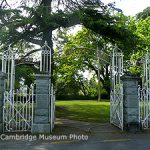
In 1997 Dinah Holman was commissioned to survey the Waikato District’s European Historic Places. Her report suggested further buildings, which add to the character of Cambridge, and these were made into a ‘B’ List by Waipa District Council, supplemental to the ‘A’ List in the Waipa District Council Plan – Appendix 10.
Dinah suggested that a survey of Maori, Archaeological and Cultural landscapes should also be carried out.
This ‘B’ List of Cambridge Historic Places is alphabetical.
Researched and written by Eris Parker
Ref: Cambridge Museum Archives
Cambridge Club Rooms – Corner Dick & Alpha Streets
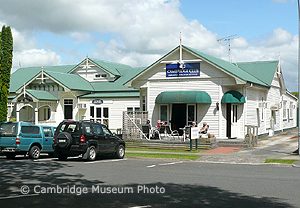
Local builder Fred Potts, with a tender of £664, got the job of building the Cambridge Club in May 1907. The architects were Messrs WS Rigby & JW Warren.
The building was of heart matai and totara, inside heart rimu. The billiard room was large enough to accommodate two tables and there was a raised dais at each end and provision for twelve gas lights. The ceiling was divided into three reeded panels and cornice mouldings. The lincrusta dado was painted in colours and above, the walls were covered in self-tinted paper with figured frieze and picture rail.
The social and card rooms had a folding door between. The interior woodwork was oiled and flat varnished. The mantlepieces were especially designed with tiled hearths and grates and glazed earthenware curbs.
The octagonal entrance hall had seats on either side.
The sides of the front entrance porch were vertical lattice work, with scrolls and brackets; the gables were timber framed and the panels covered with steel fish scales; the windows all moulded mullions with opening casements and fanlights; the front door and fanlights glazed with hammered Flemish glass.
The Clubrooms officially opened on the 24 October 1907.
In the year 2000 the Club was renovated and incorporated ‘Victoria’s Function Lounge’ and in 2003 the building was sold to the law firm Lewis’ Barristers and Solicitors, who have leased out a portion to Sport Waikato. The Old Cambridge Club merged with the Cambridge Bowling Club on Thornton Road in 2015 /2016.
Cambridge Domain – Memorial Gates
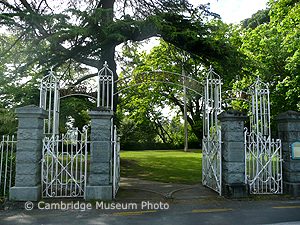
These gates, designed by McNab & Mason were erected in 1911 for £298 10 shillings in memory of Thomas Wells who was the first chairman of the Cambridge Domain Board from 1880 to 1905. The piers are Coromandel granite with polished inscribed panels worked on the blocks.
In 1929 James Hooker made a generous gift of the ornamental entrance around the Tom Wells Memorial Gates – making this a unique ‘welcome’ to the park.
Camp Cambridge – Ten Star Redoubt Site
The 3rd Waikato Militia Regiment moved to Cambridge in July 1864. Nearly 800 men were stationed on both sides of the river, and Camp Cambridge, covering 13 acres, was built on the eastside looking towards the Maori King Country. This triangle of land was bordered by Victoria, Fort and Duke Streets.
A fortified redoubt was set on 2½ acres surrounded by 12 feet deep ditches and a 14 feet high palisade fence.
At the beginning of 1865 the militiamen were allotted their town acres and 50 acre farms in the surrounding district. Most of the ground was either sour or swamp. The militia was disbanded in 1867, the Thames Goldfields called, and in 1872 an Armed Constabulary census counted only 35 farmers working their farm land.
Scrub, fern and titree made a fairly bleak outlook and trees were soon planted as shade from the sun, and shelter from the bitterly cold southerly winds. Today an inheritance of magnificent specimens has made a name for Cambridge, New Zealand as The Town of Trees.
Dairy Factories
At the beginning of the 1900s numerous co-operative dairy companies had been formed throughout the country. Watt and Hally’s factory at Hautapu was not big enough to take the milk from the newly established dairy farms which evolved from the large estates being cut up for closer settlement.
The Cambridge Co-operative Dairy Company (incorporated 17 July 1901) bought Watt and Hallys factory for £2,068 and was promised the milk from 1,000 cows. In April 1908 Fred Potts won the tender of £1,890 8s for a new brick factory building at Hautapu, to replace the one taken over from Watt and Hally. The architect was JW Warren and the opening took place on 3 September the same year.
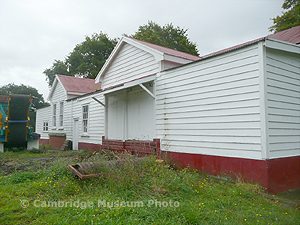
The Leamington factory was built in 1902 by Mr Hogan for £151.
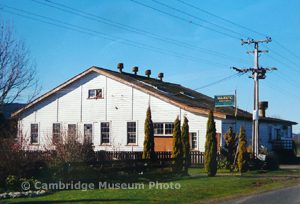
The Fencourt factory was also built in 1902 with labour from the local settlers.
In 1907 Fred Potts transferred the Fencourt factory to the present site but 15 February 1941 saw the factory building razed to the ground. A new cheese factory, completed by Speight Pearce Nicoll & Davys, was erected on the foundations of the old factory and cost £10,000. Eight of the nine vats (each of 900 gallons and working two shifts) produced 840 tons of cheese. Fencourt absorbed some of the supply from the Victoria Road factory (which had also burnt down) and nearly doubled previous output.
In 1950 the factory changed to casein manufacture and in 1962, with the impact of tanker supply, it was considered no longer a productive unit. A farewell was held on the 4th July 1962 with an informal gathering at the factory of past and present suppliers.
A petition in 1910 from Monavale settlers resulted in another creamery and four roomed cottage, being built for £239 7s 6d by Giles Brothers & Lund. It closed 1965.
Fencourt Church
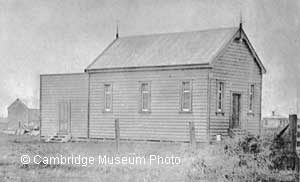
Primitive Methodist services were held in the Goodwood school with Beer, Jamieson, Simpson and Read families to the fore. They met 30 April 1907 to consider their own building and Mrs Robina Jamieson allowed ½ acre to be taken from her lease and sold to the Methodists for a church for £2 2s 6d. A trust was formed and the church building began. The foundation stone was laid on 25 September 1907 with material coming to £150 and the tender of Mr H White for labour £22 10s was accepted. Charles Reid was the architect. The church, 30 feet by 20 feet and made of rimu, was opened on 11 November 1907 .
The Methodists, originally four separate churches, were keen to unite in one church. In 1896 three groups joined to form the Methodists and the Primitive Methodists found the time was right when New Zealand Methodists became independent from Britain and Australia.
The final meeting of Primitive Methodists was held 11 April 1913.
Gasworks
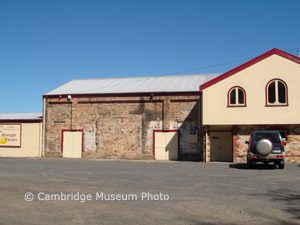
The Gasworks, on Alpha Street down towards the Waikato River, opened in 1907 at a total cost of £5,500. The first retort was charged by Mayor Buckland and the Council Chambers were lit with gas for the first time on 25th April 1907.
Additions of a man’s room, coal store and new retorts were made in 1911 and Cambridge also benefited from the coke, and tar for sealing the streets. Automatic lighting was introduced in 1912 as satisfactory lamplighters are not easy to get.
The introduction of electricity in 1921, from the Horahora power station curtailed expansions and the plant finally closed down in November 1954 having run at a loss since 1949.
For many years the old retort house was used as the borough depot until bought by the Cambridge Repertory Society in 1982 to become Cambridge Repertory’s ‘Gaslight Theatre’.
Hitching Rail
At one time every veranda post in Victoria and Duke Streets had its own hitching ring. There were also single posts placed outside homes, the Post Office and the library. A tree at St Andrews church had four rings screwed into it.
But now the only Hitching Rail left in Cambridge is on the corner of Duke and Anzac Streets.
A blacksmith, Thomas Gemmill, established his ‘smithy’ on the opposite corner in 1866 and from this point the transport industry of Cambridge spread.
Houses
Different architecturally designed houses were put on this B List from square and Victorian villas, bungalows – roughcast and wooden, flat roofed art deco, etc. Others which could be included are our first State houses of 1938. Gerrand Homes of the 1950s. Brick houses of the 1950s and 1960s as the Dutch brought their skills to Cambridge. Lockwood Homes.
Yesterday was History
Intermediate / Middle School
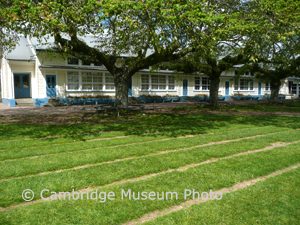
Cambridge Intermediate School on the corner of Clare and Grey Streets was first established as the High School in 1928. Then in 1953 Forms One and Two pupils made up the Intermediate Department attached to the High School. This changed again in 1963 when the present High School moved to Swaynes Road .
Arbor Days throughout the 1950’s and 60’s saw the planting of many trees and shrubs around the grounds and of special note are the Wych Elms.
Kaipaki School
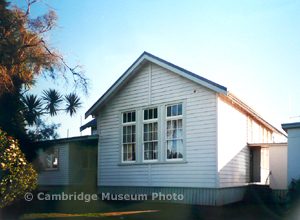
A school at Pukerimu was started in 1876 near Walker’s Gully on land gifted by Robert Fisher. The children came from quite some distance, some crossing the river by punt from Hautapu.
The school became the social centre for the district and the meeting place for the newly formed Pukekura Road Board – the first ‘local body’ in the Cambridge area. In the early 1880’s the school was also the Post Office with mail arriving twice a week from Ohaupo.
A new school was built and opened in June 1920 closer to the Kaipaki end of the district and called the Kaipaki District School.
Kaipaki Church
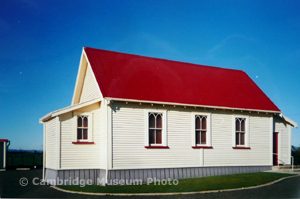
In 1871 the first church built was by the Methodists and used alternatively by Methodists and Presbyterians. In 1901 it was moved, with the help of a traction engine, to the present site. In 1926, when it was due for repair, the proposal of a new non-denominational church was agreed to with trustees from each of the Methodist, Presbyterian and Anglican churches. This new church was opened in 1928.
Maungatautari School built 1902-03 by Hampton and Rice for £215 15 shillings.
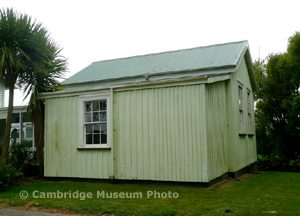
Maungatautari Teacher’s Residence built 1905 by Carter and Ross for £375.
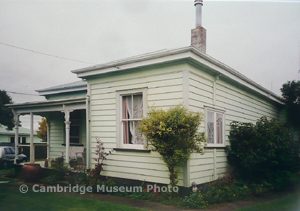
Maungatautari Hall built 1910-1911.
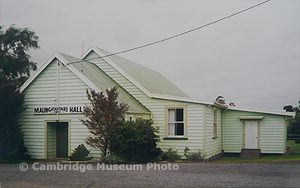
Power Board Building
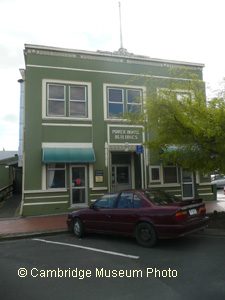
This building has had a powerful impact on Cambridge and district since being built in 1925. The Cambridge Electric Power Board came into operation in January 1920 as electricity became available from the old Horahora Power Station – built for the Waihi Gold Mining Company in 1913 and now submerged in Lake Karapiro.
The Power Board Building was built by Speight Pearce Nicoll & Davys and joineryman Jack Savory in 1925, from plans by the architects Edgecombe & White at the cost of £3,174 4s 6d. The Waikato Independent reported – ‘While the outstanding feature of the general appearance is one of substance and utility, the style of architecture is distinctly pleasing to the eye. Inside all doors and joinery are of rimu, steel framed windows and white tiled sills, while all corners in the building are rounded.’
A concrete substation (the original rear part of the building and now a restaurant) was built in 1921. The Cambridge Power Board had been formed in January 1920, after the government bought the Horahora power station.
Leamington was the first district in the Waikato to benefit from this electricity and during a celebration on 29 April 1921 the Leamington hall was ceremoniously flooded with a magnificent light from nine powerful lamps. Electric street lighting was switched on by Peter Lewis (the son of the Mayor Sam Lewis) a year later.
The Karapiro Hydro Dam provided our electricity from 1947, now having joined the National Grid.
Rejuvenated in 1992 the Power Board building now accommodates various businesses and the Cambridge Power Board has amalgamated with Te Awamutu to become Waipa Power.
Roman Catholic Church – St Peters
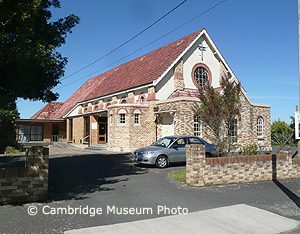
Since 1865 the Catholics had met in the Post Office building in Chapel (Anzac) Street. In 1871 they bought the land and continued meeting in the building until they bought the adjoining acre in 1877 and built a new church.
This was demolished in 1926 and the foundation stone for the present building was laid in November 1925. It is inscribed “This stone was blessed and laid by His Lordship the Rt. Rev. H W Cleary, Bishop of Auckland, Nov. 15, 1925.”
The church was built by Speight Pearce Nicholl & Davys for £2,975 from plans by John E Chitty. It was described as a Romanesque style with the bricks used to make patterns and the round window at the front.
In 1959 a new front and extensions were carried out and another $50,000 of improvements were added in 1980. Again the entrance was modified, walls were extended and seating rearranged. Outside a courtyard was laid with gardens and seats.
Victoria Street Facades – North Side
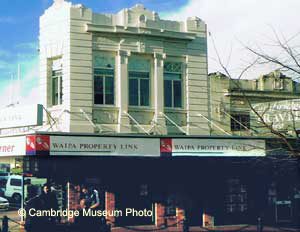
Miss Frances Davies, original owner of the corner section, displayed every confidence in Cambridge when she had this elaborate two storeyed building erected in late1931. The local building firm of Speight Pearce Nicoll & Davys won the tender for this building.
It has the look of the Art Deco era with a sea shell motif on the parapet, a face and festoons on the elaborate pediment, suspended verandas and beautiful leadlight windows set in steel frames.
H J Salter watchmaker and jeweller, was first to inhabit the new building which is still a gem in today’s streetscape.
In 1979 Mrs Frances Benn nee Davies had died and her building was sold when her estate was finalised. A A Moore the dentist occupied the top storey and a Real Estate on the ground floor.
Farmers’ Meat Co. (Cambridge Travel)
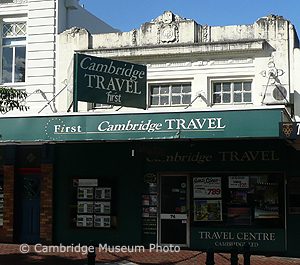
Harry Webb the butcher also built new premises in 1931. Speight Pearce Nicoll & Davys were again the successful tenders at about £1,700. It was one storey, comprising two shops and coming to a triangular point at the rear. It is made with reinforced concrete with bevelled glass in the front doors and ornamental bronze grill over the doors and windows. The ornamental parapet has a shield with FMCo and ornamental foliation and festoons.
W Cubis (Wine Cellar)
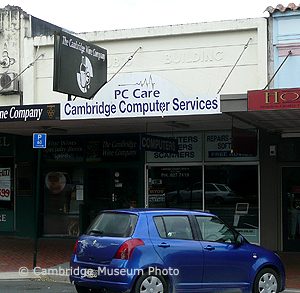
W H Cubis’ grocery started in 1933 on the corner and later he bought nearby premises from C W Atkinson (fabric merchant) and Rendezvous Tea rooms.
In 1972 he closed the grocery and the Wine Cellar moved into W H Cubis Building where they built an attractive new front.
Easters (Fashion & Health)
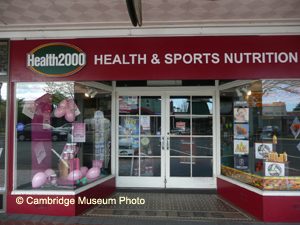
Built in 1930 for Easters shoestore this building has retained its leadlight windows, tiled entrance and interesting pressed metal veranda ceiling.
The upper facade has a Spanish look with tiles and pilasters.
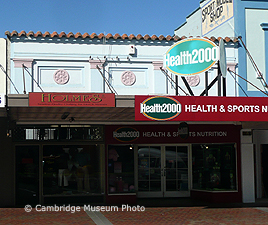
Mrs Watson (Model Shop)
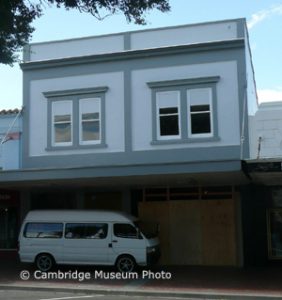
Emma was the wife of Arthur Watson who had another building further down Victoria Street built at the same time. This building remained with Emma until the late 1930’s.
In September 1929 a fire in the building destroyed Mrs Howden’s ‘Adrienne’ milliner and lady’s outfitter.
Nixon (Gifts / Waynes / Edmeades)
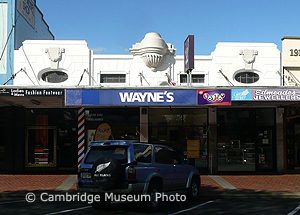
Towards the end of 1929 Speight Pearce Nicoll & Davys made a start on the concrete premises for Mr B Nixon. These were next to Calvert’s, on a site recently razed by a fire. The four new shops were built of reinforced concrete, quite narrow with small display windows finished with leadlight windows. The upper facade is decorated with oval windows and garlands.
Calvert’s Buildings – Victoria Street
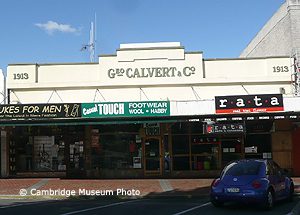
Geo Calvert & Co Ltd was a large Cambridge institution carrying various lines from buttons and lace to King Size beds.
Samuel Howard started the business in 1893 as ‘Cambridge House’. Robert Taylor Tudehope took over in 1901 and almost immediately replaced the original wooden building with new brick premises.
From the 1st January 1913, George Calvert took over the business. He had worked for Smith & Caughey in Auckland and arrived in Cambridge with his wife and family.
In 1928 the window frontage and verandahs were modernised for the sum of £1,200.
In July 1985 it was announced that Calverts had sold the building and fittings, to the Post Office, and the business closed down. The Post Office planned to demolish the premises and rebuild.
However, with the restructuring of PostBank, the building was later passed over and a developer moved in.
(New Centreway)
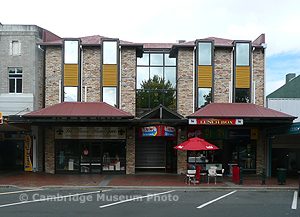
At the beginning of the 20th century the bakery started as a Confectionery and Dining Rooms run by Misses Blackmore and Tring. J Dunning had a two storey brick building built in 1908. The architect, E Bartley had 12 tenders to choose from ranging from £1,509 to £1,917. Upstairs was a flat and the Lyceum club started there in 1942.
Collins Bakery, Cambridge Travel Agency and the Lunch Box were last in the building which was pulled down in 1982. Cantab Investments built Cambridge’s only three storey building designed by architect Colin Porton, with no compassion for the surrounding architectural designs.
E H Leigh Chemist
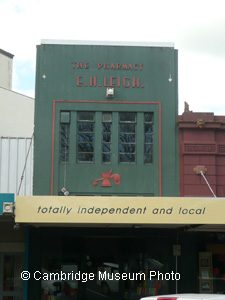
In October 1937 E H Leigh had A I Gate of Hamilton build a new double-storey pharmacy from plans by his son G Innes Leigh. It was painted pastel green with cream facings and was said to resemble many of the new buildings in Napier. The display windows had chrome fittings and black vitrolite above and below the plate glass. The open fireplace was also designed with chrome and black vitrolite fittings.
A pestle and mortar are worked into the decorations on the front of the building.
(Veale) Bookshop
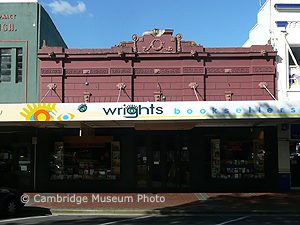
This block of shops was built in 1930 for F S Veale of ferro concrete with a 35 feet 8 inches shop frontage divided into three shops. It was made in the same style as Easters and Waghornes with a scrolled, festooned pediment and patera with date, lions heads and meander pattern frieze.
Chemist
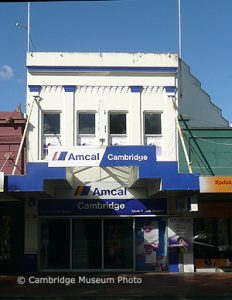
In 1903 Edward Boucher Hill, chemist had this brick building built.
Sports Shop
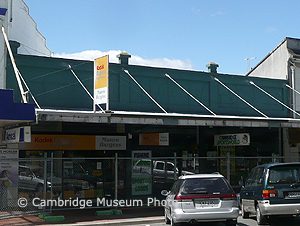
R W Magill originally conducted a clothing business (next to the Triangle) which was taken over by A Dan Sayers and Mr W J Ward in 1921. In 1979 this was run as Marsden Sayers Ltd.
Farmers and Post Bank have also been in this building.
The Triangle
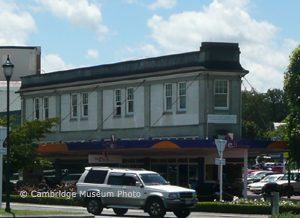
In August 1919 the old Arnold Butchery property was bought by Priestley and Wallace and they had built the two-storeyed concrete building, seen today. H Clinton Savage was architect and G B Braithwaite was the builder. Both were from Auckland. Local firms were used as the glass was ordered through SPND and the iron for the reinforcing was done by John Ferguson.
The top floor was originally the Tea Rooms run by Miss McDevitt who served luncheon and afternoon teas. Many people also had their wedding breakfasts there. The bottom floor was taken by D Congalton, stationer and books, and the corner shop by Alf Boyce watchmaker and jeweller. Boyce bought out Congalton and ran the combined business until Tom Cummings bought the stationery-book shop.
Priestleys Building 1913 (South Victoria Street)
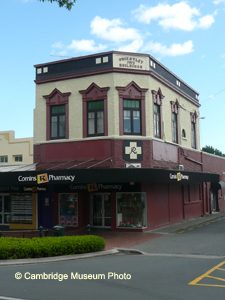
Charles H Priestley arrived in Cambridge in 1907 and bought the property on the corner of Victoria Street and the right of way to Duke Street (Hallys Lane). His business of saddler and harness maker grew as he added leather goods and sporting equipment. He bought out M D Nicholas’ saddlery business and had his two-storey reinforced concrete building constructed in 1913 by F & W Marcroft.
The bottom floor was the saddlery and workshop with a sample room opening onto the right of way. A strongroom was built under the stairs and upstairs were dental rooms and two offices – all lit with gas.
The outside was plastered and painted, the casement windows have hoods and the entrance is tiled. The verandas – a novelty for Cambridge – were suspended and there were four large show windows.
Central Hotel
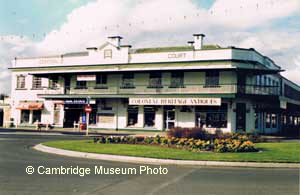
The Central Hotel on the corner of Duke and Empire Streets, which was formerly the Criterion Hotel, and built on the site of the Duke of Edinburgh Hotel, is now Central Court.
The Criterion Hotel was built by Madigan & Miller in 1877. The name changed to the Central Hotel in 1908 and today’s building was erected after a fire in 1926 from plans by James T Douce. It still has a pediment, parapet and chimney pots.
It was converted into shops in 1977 after being auctioned off when the DB licence went to the Cambridge Tavern in Leamington. The building now accommodates one of our many antique shops, Colonial Heritage Antiques.
Veale Buildings
This building, on the corner of Duke and Victoria Streets, was constructed in August 1928 for £4,600 from plans by architect James T Douce. 69 feet of shop frontage was in Duke Street, 31 feet 6 inches on the corner and 52 feet in Victoria Street.
‘Whitiora’ Nursing Home
After a fire burnt Nurse Helen Russel’s Victoria Nursing Home in Hamilton Road in 1921, the first floor of ‘Whitiora’ was rebuilt by C W Cooper in 1926 from plans by J T Douce, for £1,920. In 1934 the second storey was added by Speight Pearce Nicoll & Davys and became known as ‘Whitiora Nursing Home’ run by Sisters McConachie and Pettigrew.
When the new Cambridge Maternity Hospital was built in 1962 ‘Whitiora’ became a geriatric hospital, then boarding house and flats. In 1974 ‘Penmarric Restaurant’ was born and became well known for its Devonshire teas; then lunches; and by the 1980’s it had become a top Waikato restaurant.
With the interior walls striped of their plaster, the bricks were laid bare and many Cambridge diners had a first class meal in the room in which they were born.
This building is now a private residence.
Disclaimer:
While all due care has been taken to verify information contained on this site, the Cambridge Museum accepts no responsibility for any errors, omissions or misrepresentation.
Copyright © 2003 – Cambridge Museum – All Rights Reserved.
